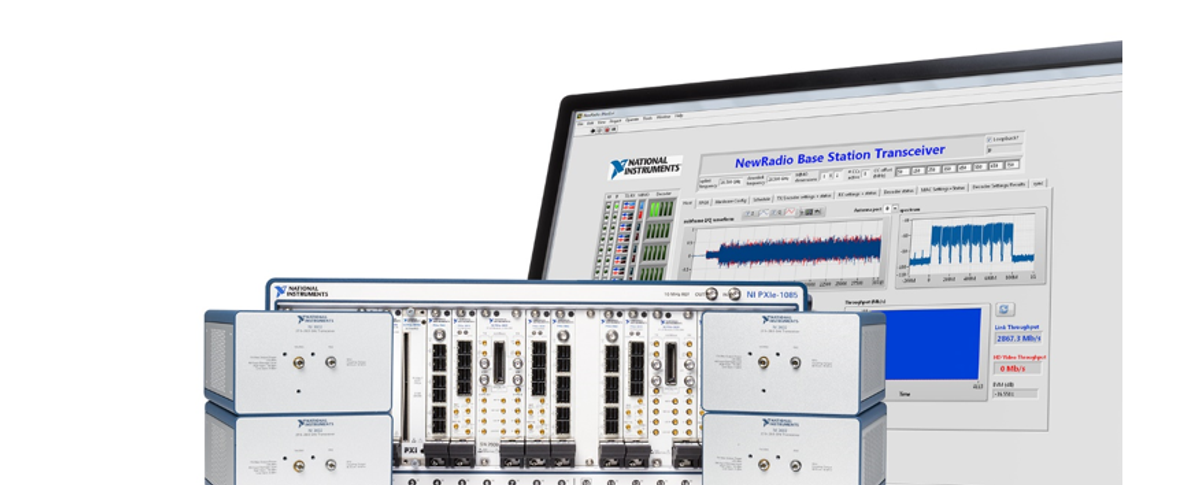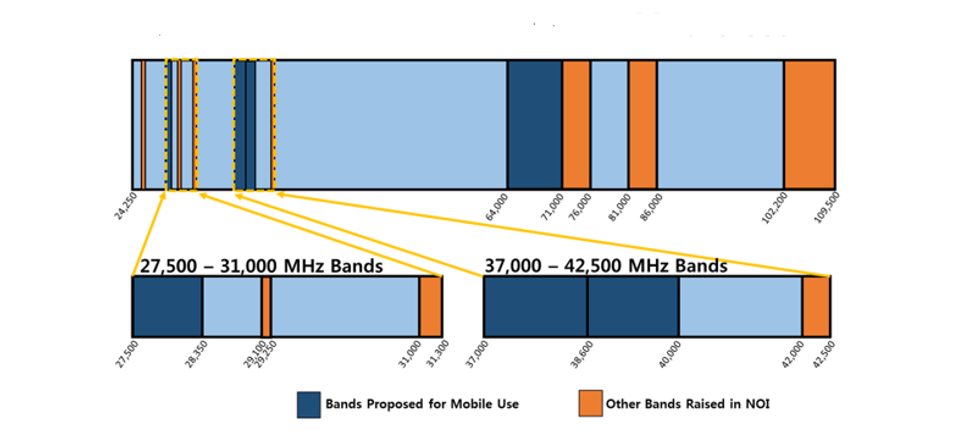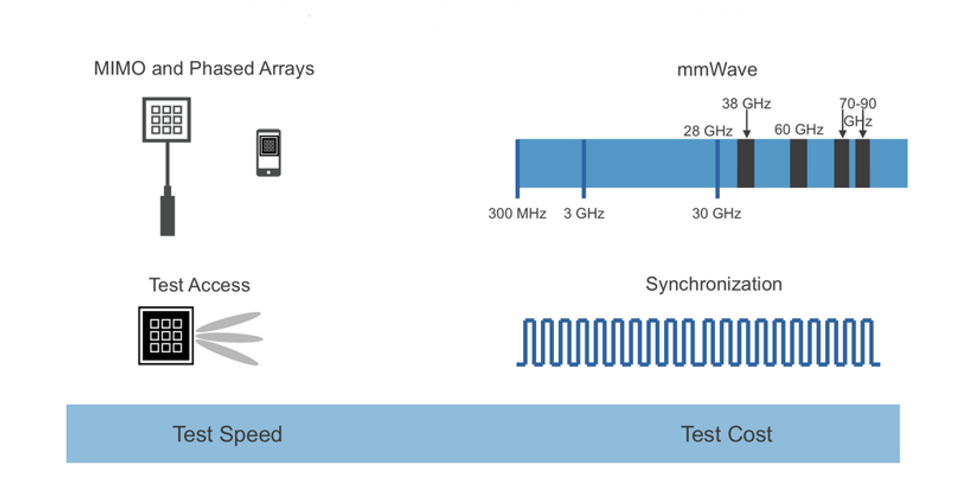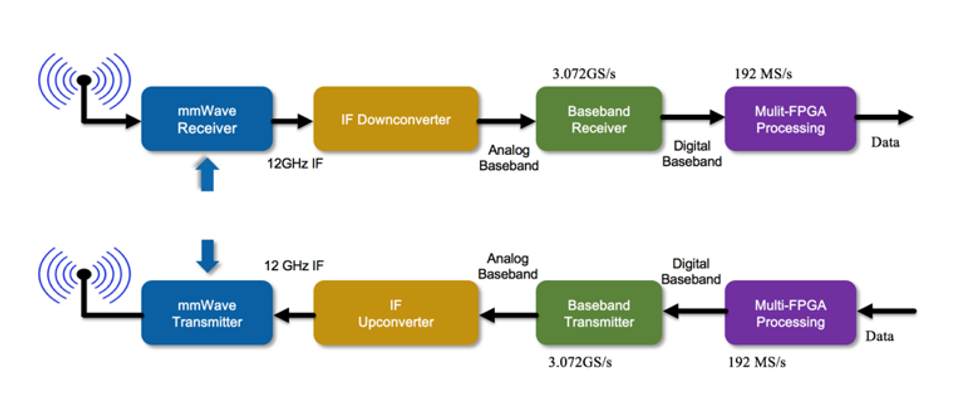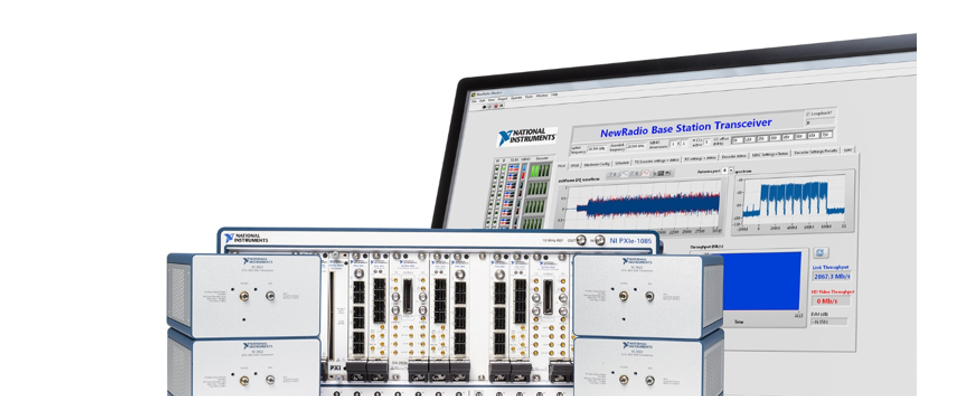The role of high-precision test solutions is going to be crucial in early 5G chipset prototyping, development and device design validation. The advent of 5G networks marks the most disruptive change in the mobile industry since the transition from analog to digital back in the early 1990s. Now add to this the relatively unknown millimeter wave (mmWave) technology that needs far more robust phase coherence due to wider signal bandwidths, and what is at hand is a brand new test frontier.
The 5G networks will employ a broad range of spectrum frequencies, including the popular 28 GHz and 39 GHz 5G mmWave bands. Here it’s worth noting that while LTE will be an integral part of 5G networks, the role of mmWave frequencies is likely to grow due to the availability of plentiful spectrum as well as aggregated channel bandwidth of 1 GHz and higher.
At the same time, however, 5G mmWave frequencies (Figure 1) will require more sophisticated test solutions for chipsets, mobile devices, network infrastructures and cybersecurity. That’s because these airwaves travel at shorter distances and are more susceptible to radio propagation loss issues.
The commercialization of mmWave technology is accelerating amid the launch of the 5G New Radio (NR) standard, and this calls for a chronicle of major challenges that the traditional spectrum analyzer-based test solutions cannot manage efficiently and cost-effectively. This also calls for a sneak peek of test solutions that are viable from cost and design standpoints for the rapidly evolving mmWave 5G technologies.
Brand New Test Frontier
The mmWave frequencies demand more sophisticated RF parametric measurements for signal gain, directivity, beamwidth and antenna efficiency. These RF parametric measurements become even more challenging because of 5G’s smaller device size and array size. Then, there are propagation loss issues at higher mmWave frequencies, where signal power can quickly diminish due to environmental conditions like rain or snow.
The antenna is especially a sensitive area in mmWave frequencies because of the phase arrays and the need for greater accuracy in gain measurements. Therefore, the use of smart adaptive antennas in phase arrays poses additional test challenges.
Moreover, while 4G LTE terminal devices like smartphones have several built-in antennas, those for 5G will have a significantly higher number of antennas. Having a measurement connector for each antenna could cause problems for test engineers, especially when the size of mobile devices is continuously shrinking. In fact, many 5G components do not even have connectors, and therefore, cannot be tested in conducted setups.
Another critical issue in 5G device radio performance testing and validation is the diverse deployment of radio spectrums. For now, 28 GHz and 39 GHz 5G millimeter wave bands are the most popular, but eventually 5G networks could employ mmWave frequencies ranging from 26.5 GHz to 67 GHz. Therefore, the test solution must provide far field radio characterization capabilities — gain, directivity, beamwidth, 3D radiation pattern and antenna efficiency — across a broad range of mmWave frequencies.
However, while there is intense pressure to develop high-precision test solutions for 5G mmWave products spanning from the semiconductors to end systems, traditional approaches can often balloon the test costs. And the fact that test and measurement platforms must adapt to quickly evolving 5G standards creates another challenge.
Testing mmWave Signals
The field trials for 5G mmWave radios have already started generating and analyzing frequency bands of up to 40 GHz. And what has been discovered here is that measuring the parameters, like signal profile, range and capacity for higher-gain antennas steering more powerful beam signals in mmWave communications, is far more challenging than LTE testing.
What is also apparent is that the 5G systems are using more system-in-package implementations, which means that testing will happen both at the component and system levels. Therefore, packaging technology advancements must align with the over-the-air (OTA) test methodologies to create more repeatable test procedures and thus keep the overall test cost in control.
Take, for instance, 5G transceivers, which in many cases need to be tested in conjunction with the antennas. The 5G designs are increasingly implementing system-in-package solutions, which means that antennas also come integrated with an RF front-end module (FEM) and transceivers.
Therefore, what is really needed is a flexible hardware platform that can be modified by adding or removing modules to test a wide range of 5G devices, channels and network configurations. For example, test engineers can use the same test system to prototype different mmWave bands with the same intermediate frequency (IF) and baseband hardware and software.
The following section presents a design case study based on the mmWave Transceiver System (Figure 3), a prototyping solution that employs a flexible hardware platform and application software to test a variety of mmWave applications in real time.
The mmWave Prototyping System
The critical importance of 5G mmWave prototyping systems lies in the fact that the properties of an mmWave channel are different from an LTE cellular channel. Additionally, these prototyping platforms can unravel the viability and feasibility of 5G mmWave communications in a way that simulation programs alone cannot.
The mmWave Transceiver System, based on the software-defined radio (SDR) technology, is a test platform that National Instruments (NI) introduced for 5G and other advanced wireless communication systems in 2016. It operates as an over-the-air communication system for a variety of 5G applications, ranging from channel sounding to MIMO link measurement.
This open communication prototype overcomes the complexity of processing multi-gigahertz channels by providing an mmWave physical layer in the source code that encompasses the fundamental aspects of the mmWave baseband subsystem. Furthermore, the software in the mmWave Transceiver System is open to developers for modifications in different design iterations.
That allows developers to modify the source code for a wide range of applications such as channel sounding, 5G NR algorithm development and optimization and beamsteering algorithm testing.
Now NI has unveiled two new mmWave radio heads for connecting RF components to IF modules that convert signals to 12 GHz in the mmWave Transceiver System (Figure 4). These radio heads — targeted at prototyping NR 5G systems operating at 24.5 GHz to 33.4 GHz and 37 GHz to 43.5 GHz frequency bands — are compatible with the previously released mmWave radio heads.
The physical layer provided in the source code is created using NI’s LabVIEW software and is compatible with the Verizon 5G TF specification and Release 15 of 3GPP’s 5G NR specifications.
Summary
An off-the-shelf mmWave prototype system is a good starting point to understand the characteristics of a new mmWave band and to begin conducting the 5G measurements. And its software can quickly adapt to the new mmWave spectrums as well as the evolving 5G standards.
The mmWave prototype system is comprised of modules that can be assembled in various configurations and serve more than one 5G test applications. They also take away the massive complexity associated with the 5G device design and network configurations.
